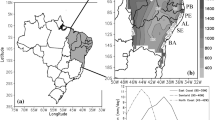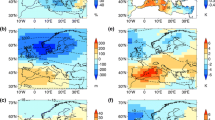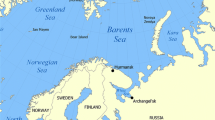Abstract
This paper reports on a method using composites for studying synoptic conditions of a series of windstorm events selected on the basis of maximum wind speeds in Switzerland. The composite storm-averaged conditions indicate how flow fields, as well as related surface conditions, are organised so as to produce high wind speeds near the surface. On average, high winds in Switzerland, mainly generated by transient synoptic-scale eddies, are characterised by a minimum in the mean sea level pressure field over southern Norway, anticyclonic conditions south of 35°N and a steep pressure gradient over continental western Europe. The geopotential aloft has a predominant zonal structure, producing high winds between 45°N and 50°N over the eastern Atlantic and further inland; the jet stream has its maximum speed at 50°N over the Celtic Sea and Brittany at 250 hPa. Close to the surface, large temperature contrasts between the warm waters of the Atlantic Ocean and Mediterranean Sea and the cooler continent are diagnosed. The results thus obtained differ to those produced by other methods based on the analysis of deep cyclones or of strong vorticity in the northern North Atlantic Ocean basin. Differences of the composite mean synoptic conditions for current (1961–1990) and future climate (2071–2100) as simulated by the Global Climate Model HadAM3H in the context of the EU PRUDENCE project indicate that windstorms in a warmer world are generated by a subtle modification of the atmospheric baroclinicity, especially over the ocean and where greater ocean-continent temperature contrasts are simulated during winters. However, there are no signs of reduced storm activity as the climate warms by the end of the twenty-first century.








Similar content being viewed by others
References
Alexandersson H, Tuomenvirta H, Schmith T, Iden K (2000) Trends of storms in NW Europe derived from an updated pressure data set. Clim Res 14:71–73
Bärring L, von Storch H (2004) Northern European Storminess since about 1800. Geophys Res Lett 31:L20202. doi:10.1029/2004GL020441
Bengtsson L, Hodges KI, Roeckner E (2006) Storm tracks and climate change. J Clim 19:3518–3543
Bengtsson L, Hodges KI, Keenlyside N (2009) Will extratropical storms intensify in a warmer climate? J Clim 22:2276–2301
Beniston M, Stephenson DB, Christensen OB, Ferro CAT, Frei C, Goyette S, Halsnaes K, Holt T, Jacob D, Jylhä K, Koffi B, Palutikof J, Schöll R, Semmler T, Woth K (2007) Future extreme events in European climate: an exploration of Regional Climate Model projections. Clim Change 81:71–95. doi:10.1007/s10584-006-9226-z
Biner S, Caya D, Laprise R, Spacek L (2000) Nesting of RCMs by imposing large scales. In: Research activities in atmospheric and oceanic modelling, WMO/TD-No. 987, Report No. 30, 2000, pp 7-3–7-4
Blackmon ML (1976) A climatological spectral study of the 500-mb geopotential height of the Northern Hemisphere wintertime circulation. J Atmos Sci 33:1607–1623
Boer GJ (1995) Some dynamical consequences of greenhouse gas warming. Atmos Ocean 33:731–751
Branscome LE, Gutowski WJ (1992) The impact of doubled CO2 on the energetics and hydrologic processes of mid-latitude transient eddies. Clime Dyn 8:29–37
Carnell RE, Senior CA (1998) Changes in mid-latitude variability due to increasing greenhouse gases and sulphate aerosols. Clim Dyn 5:369–383. doi:10.1007/s003820050229
Caron J-F, Zwack P, Pagé C, cited (2005): DIONYSOS: A diagnostic tool for numerically-simulated weather systems. http://www.dionysos.uqam.ca/documentation_e.html
Caya D, Laprise R (1999) A semi-implicit semi Lagrangian regional climate model: the Canadian RCM. Mon Weather Rev 127:341–362
Chang EKM, Song S (2006) The seasonal cycles in the distribution of precipitation around cyclones in the Western North Pacific and Atlantic. J Atmos Sci 63:815–839. doi:10.1175/JAS3661.1
Chang EKM, Lee S, Swanson KL (2002) Storm tracks dynamics. J Clim 15:2163–2183
Christensen JH, Carter TR, Giorgi F (2002) PRUDENCE employs new methods to assess European climate change. EOS 83:147
Della-Marta PM, Pinto JG (2009) Statistical uncertainty of changes in winter storms over the North Atlantic and Europe in an ensemble of transient climate simulations. Geophys Res Lett 36:L14703. doi:10.1029/2009GL038557
Fink AH, Brücher T, Ermert E, Krüger A, Pinto JG (2009) The European storm Kyrill in January 2007: Synoptic evolution, meteorological impacts and some considerations with respect to climate change. Nat Hazards Earth Syst Sci 9:405–423
Fischer-Bruns I, von Storch H, González-Rouco JF, Zorita E (2005) Modelling the variability of midlatitude storm activity on decadal to century time scales. Clim Dyn 25:461–476
Fuhrer J, Beniston M, Fischlin Ch A, Goyette Frei S, Jasper K, Pfister C (2006) Climate risks and their impact on agriculture and forests in Switzerland. Clim Change 79:79–102. doi:10.1007/s10584-006-9106-6
Gitelman A, Risbey J, Kass R, Rosen R (1997) Trends in the surface meridional temperature gradient. Geophys Res Lett 24:1243–1246
Goyette S (2008) Development of a model-based high resolution extreme surface wind climatology for Switzerland. Nat Hazards 44:329–339. doi:10.1007/s11069-007-9130-5
Goyette S, Beniston M, Caya D, Laprise JPR, Jungo P (2001) Numerical investigation of an extreme storm with the Canadian Regional Climate Model : The case study of windstorm VIVIAN, Switzerland, February 27, 1990. Clim Dyn 18:145–178
Goyette S, Brasseur O, Beniston M (2003) Application of a new wind gust parameterisation. Multi-scale case studies performed with the Canadian RCM. J Geophys Res 108(D13):4374–4390
Greeves CZ, Pope VD, Stratton RA, Martin GM (2007) Representation of Northern Hemisphere winter storm tracks in climate models. Clim Dyn 28:683–702
Gulev SK, Zolina O, Grigoriev S (2001) Extratropical cyclone variability in the Northern Hemisphere winter from the NCEP/NCAR reanalysis data. Clim Dyn 17:795–809
Hall N, Hopkins B, Valdes P, Senior CA (1994) Storm tracks in a high-resolution GCM with doubled carbon dioxide. Q J Roy Meteorol Soc 120:1209–1230. doi:10.1002/qj.49712051905
Held IM (1993) Large-scale dynamics and global warming. Bull Am Meteorol Soc 74:228–241
Heneka P, Hofherr T, Ruck B, Kottmeier C (2006) Winter storm risk of residential structures—model development and application to the German state of Baden-Württemberg. Nat Hazards Earth Syst Sci 6:721–733
Holton JR (2004) An introduction to dynamic meteorology. International geophysics series, 4th edn. Academic Press (Elsevier), New York, 535 pp
Hoskins B, Valdes PJ (1990) On the existence of storm tracks. J Atmos Sci 47:1854–1864
Houghton JT (2005) Global warming. Rep Prog Phys 68:1343–1403. doi:10.1088/0034-4885/68/6/R02
Iskenderian H, Rosen R (2000) Low-frequency signals in midtropospheric submonthly temperature variance. J Climate 13:2323–2333
Kalnay E et al (1996) The NCEP/NCAR 40-years reanalysis project. Bull Am. Meteorol Soc 77:437–471
Knippertz P, Ulbrich U, Speth P (2000) Changing cyclones and surface wind speeds over the North Atlantic and Europe in a transient GHG experiment. Clim Res 15:109–122
Kunkel KE, Pielke RA, Changnon S A Jr (1999) Temporal fluctuations in weather and climate extremes that cause economic and human health impacts: a review. Bull Am. Meteorol Soc 80:1077–1098
Lambert SJ, Fyfe JC (2006) Changes in winter cyclone frequencies and strengths simulated in enhanced greenhouse warming experiments: Results from the models participating in the IPCC diagnostic exercise. Clim Dyn 26:713–728
Lambert S, Sheng J, Boyle J (2002) Winter cyclone frequencies in thirteen models participating in the Atmospheric Model Intercomparison Project (AMIP 1). Clim Dyn 19:1–16
Land C, Feichter J (2003) Stratosphere-troposphere exchange in a changing climate simulated with the general circulation model MAECHAM4. J Geophys Res 108:8523
Laprise R, Caya D, Bergeron G, Giguère M (1997) The formulation of the André Robert MC2 (mesoscale compressible community) model. Atmos Ocean 35:195–220
Laprise R, Caya D, Giguere M, Bergeron G, Côté H, Blanchet J-P, Boer GJ, McFarlane NA (1998) Climate and climate change in Western Canada as simulated by the canadian regional climate model. Atmos Ocean 36:119–167
Leckebusch GC, Ulbrich U (2004) On the relationship between cyclones and extreme windstorm events over Europe under climate change. Glob Planet Change 44:181–193
Leckebusch G, Koffi B, Ulbrich U, Pinto J, Spangehl T, Zacharias S (2006) Analysis of frequency and intensity of European winter storm events from a multi-model perspective, at synoptic and regional scales. Clim Res 31:59–74
Lindzen RS, Farrell B (1980) A simple approximation result for the maximum growth rate of baroclinic instabilities. J Atmos Sci 37:1648–1654
Lionello P, Boldrin U, Giorgi F (2008) Future changes in cyclone climatology over Europe as inferred from a regional climate simulation. Clim Dyn 30:657–671. doi:10.1007/s00382-007-0315-0
Löptien U, Zolina O, Gulev S, Latif M, Soloviov V (2008) Cyclone life cycle characteristics over the Northern Hemisphere in coupled GCMs. Clim Dyn 31:507–532. doi:10.1007/s00382-007-0355-5
McFarlane NA, Boer GJ, Blanchet J-P, Lazare M (1992) The Canadian climate centre second generation general circulation model and its equilibrium climate. J Clim 5:1013–1044
Munich Re (1999) Topics 2000—natural catastrophes—the current position, Munich, pp 126. http://www.munichre.com
Nakićenović N et al (2000) IPCC special report on emissions scenarios. Cambridge University Press, Cambridge 599 pp
Nielsen JW, Dole RM (1992) A survey of extratropical cyclone characteristics during GALE. Mon Weather Rev 120:1156–1168
Osborn TJ, Briffa KR, Tett SFB, Jones PD, Trigo RM (1999) Evaluation of the North Atlantic Oscillation as simulated by a coupled climate model. Clim Dyn 15:685–702
Paciorek C, Risbey J, Ventura V, Rosen R (2002) Multiple indices of Northern Hemisphere cyclone activity, winters 1949–1999. J Clim 15:1573–1590
Peixoto JP, Oort AH (1991) Physics of climate. American Institute of Physics, New York 520 pp
Pinto JG, Ulbrich U, Leckebusch GC, Spangehl T, Reyers M, Zacharias S (2007) Changes in storm track and cyclone activity in three SRES ensemble experiments with the ECHAM5/MPI-OM1 GCM. Clim Dyn 29:195–210
Pinto JG, Zacharias S, Fink AH, Leckebusch GC, Ulbrich U (2009) Factors contributing to the development of extreme North Atlantic cyclones and their relationship with the NAO. Clim Dyn 32:711–737. doi:10.1007/s00382-008-0396-4
Pope DV, Gallani M, Rowntree R, Stratton A (2000) The impact of new physical parameterizations in the Hadley Centre climate model HadAM3. Clim Dyn 16:123–146
Raible CC (2007) On the relation between extremes of midlatitude cyclones and the atmospheric circulation using ERA40. Geophys Res Lett 34:L07703. doi:10.1029/2006GL029084
Raible CC, Yoshimori M, Stocker TF, Casty C (2007) Extreme midlatitude cyclones and their implications for precipitation and wind speed extremes in simulations of the Maunder Minimum versus present day conditions. Clim Dyn 28:409–423
Raible CC, Della-Marta PM, Schwierz C, Wernli H, Blender R (2008) Northern hemisphere midlatitude cyclones: a comparison of detection and tracking methods and different reanalyses. Mon Weather Rev 136:880–897
Rockel B, Woth K (2007) Extremes of near-surface wind speed over Europe and their future changes as estimated from an ensemble of RCM simulations. Clim Change 81:267–280
Roebber PJ (1984) Statistical analysis and updated climatology of explosive cyclones. Mon Weather Rev 112:1577–1589
Rolfson DM, Smith PJ (1996) A composite diagnosis of synoptic-scale extratropical cyclone development over the United States. Mon Weather Rev 124:1084–1099
Rudeva I, Gulev SK (2007) Climatology of cyclone size characteristics and their changes during the cyclone life cycle. Mon Weather Rev 135:2568–2587
Sanders F, Gyakum JR (1980) Synoptic-dynamic climatology of the “Bomb”. Mon Weather Rev 108:1589–1606
Schiesser HH, Pfister C, Bader J (1997) Winter storms in Switzerland north of the alps 1864/1865–1993/1994. Theor Appl Climatol 58:1–19
Schinke H (1993) On the occurence of deep cyclones over Europe and the North Atlantic in the period 1930–1991. Beitr Phys Atmos 66:223–237
Schmith T, Kaas E, Li T-S (1998) Northeast Atlantic winter storminess 1875–1995 re-analysed. Clim Dyn 14:529–536
Schubert M, Perlwitz J, Blender R, Fraedrich K, Lunkeit F (1998) North Atlantic cyclones in CO2-induced warm climate simulations: frequency, intensity, and tracks. Clim Dyn 14:827–837
Schüepp M, Schiesser HH, Huntrieser H, Scherrer HU, Schmidtke H (1994) The winterstorm “VIVIAN” of 27 February 1990: about the meteorological development, wind forces and damage situation in the forests of Switzerland. Theor Appl Climatol 49:183–200
Serreze MC (1995) Climatological aspects of cyclone development and decay in the arctic. Atmos Ocean 33:1–23
Stephenson DB, Wanner H, Broennimann S, Luterbacher J (2002) The History of Scientific Research on the North Atlantic Oscillation. In: Hurrell JW, Kushnir Y, Ottersen G, Visbeck M (eds) The North Atlantic Oscillation: climatic significance and environmental impact. Geophysical Monograph 134, American Geophysical Union, Washington, pp 37–50
Stephenson DB, Pavan V, Collins M, Junge MM, Quadrelli R et al (2006) North Atlantic Oscillation response to transient greenhouse gas forcing and the impact on European winter climate: a CMIP2 multi-model assessment. Clim. Dyn. 27:401–420
Tanguay M, Robert A, Laprise R (1990) A semi-implicit semi-Lagrangian fully compressible regional forecast model. Mon Weather Rev 118:1970–1980
Taylor KE, Williamson D, Zwiers F (2000) The sea surface temperature and sea-ice concentration. PCMDI Rep. No 60, Lawrence Livermore Nat. Lab, California, USA, 2000, 24 pp
Trigo IF (2006) Climatology and interannual variability of storm-tracks in the Euro-Atlantic sector: a comparison between ERA-40 and NCEP/NCAR reanalyses. Clim Dyn 26:127–143
Ulbrich U, Christoph M (1999) A shift of the NAO and increasing storm track activity over Europe due to anthropogenic greenhouse gas forcing. Clim Dyn 15:551–559
Ulbrich U, Fink AH, Klawa M, Pinto JG (2001) Three extreme storms over Europe in December 1999. Weather 56:70–80
Ulbrich U, Leckebusch GC, Pinto JG (2009) Cyclones in the present and future climate: a review. Theor Appl Climatol 96:117–131. doi:10.1007/s00704-008-0083-8
von Storch H, Weisse R (2008) Regional storm climate and related marine hazards in the Northeast Atlantic. In: Diaz HF, Murnane RJ (eds) Climate extremes and society, Cambridge. Cambridge University Press, Cambridge 340 pp
Wang XL, Swail VR, Zwiers FW (2006) Climatology and changes of extratropical storm tracks and cyclone activity: comparison of ERA-40 with NCEP/NCAR Reanalysis for 1958–2001. J Clim 19:3145–3166
Wang XL, Zwiers FW, Swail VR, Feng Y (2009) Trends and variability of storminess in the Northeast Atlantic Region, 1874–2007. Clim Dyn 33:1179–1195. doi:10.1007/s00382-008-0504-5
WASA Group (1998) Changing waves and storms in the Northeast Atlantic. Bull Am Meteorol Soc 79:741–760
Weisse R, von Storch H, Feser F (2005) Northeast Atlantic and North Sea storminess as simulated by a Regional Climate Model during 1958–2001 and comparison with observations. J Clim 18:465–479
Wernli H, Dirren S, Liniger MA, Zillig M (2002) Dynamical aspects of the life cycle of the winter storm “Lothar” (24–26 December 1999). Q J Roy Meteorol Soc 128:405–429
Wilks DS (2006) Statistical methods in the atmospheric science. International geophysics series, vol 91, 2nd edn. Elsevier/Academic Press, Amsterdam/London 627 pp
Wilson MF, Henderson-Sellers A (1985) A global archive of land cover and soils data for use in general circulation climate models. J Climatol 5:119–143
Woodworth P, Blackman D (2002) Changes in extreme high waters at Liverpool since 1768. Int J Climatol 22:697–714
Zwack P, Okossi B (1986) A new method for solving the quasigeostrophic omega equation by incorporating surface pressure tendency data. Mon Weather Rev 114:655–666
Zwiers FW, Kharin VV (1998) Changes in the extremes of the climate simulated by CCC GCM2 under CO2 doubling. J Clim 11:2200–2222
Acknowledgments
The work reported in this paper is based on discussions during meetings of the EU PRUDENCE and ENSEMBLES projects that have been very useful in formulating the ideas and concepts discussed here. I would also like to thank two anonymous reviewers for their insightful comments which helped improve the manuscript. I finally thank the climate modelling team of ESCER at Montréal who developed and provide the CRCM used in this study.
Author information
Authors and Affiliations
Corresponding author
Rights and permissions
About this article
Cite this article
Goyette, S. Synoptic conditions of extreme windstorms over Switzerland in a changing climate. Clim Dyn 36, 845–866 (2011). https://doi.org/10.1007/s00382-010-0820-4
Received:
Accepted:
Published:
Issue Date:
DOI: https://doi.org/10.1007/s00382-010-0820-4




